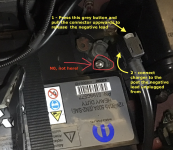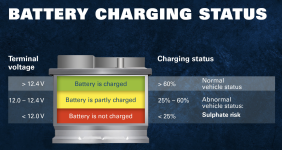Interrupting the power supply on modern vehicles is to be avoided if at all possible due to the problems which often result. Consequently I keep a 12 volt battery which I can connect in parallel with extension leads if I have to completely remove a lead from the installed battery, say when fitting a new one for instance. (mind you, on the Panda you can disconnect the leads with "gay abandon" and loose nothing when it's reconnected.)
In my younger days I would not have hesitated to hook my old transformer type charger up to my Mini or Cortina when I went to bed safe in the knowledge she would be ready for me starting her up in the morning. Now a days though that would be like playing Russian roulette. The problem, as many of you will know, lies with the electronic components on modern cars and their inability to survive voltage spikes and their associated currents. So where might these "spikes" come from? Well, with the traditional transformer type chargers - usually easily enough identified because they are heavy and bulky - What comes out on the battery connection leads is directly proportional to what goes in from the mains. So, a surge in supply at the plug on the wall results in a directly related surge in output at the battery terminals and if high enough something's going to go "pop"! That's where the Russian roulette comes in. As Dirty Harry said "Are you feeling lucky"? I have a couple of these old type chargers which I would now never connect directly to a fully wired up vehicle but do use to charge normal lead acid batteries, including EFB, on the workshop bench.
The "cure" is a modern "smart" charger which uses inverter technology ( get him eh? sound like he knows what he's talking about? ) and electronically monitors and controls the output so that mains "spikes" do not get through to the output side. Some where in the early 20's a number of the ancient vehicles in "the family fleet" just wore out from old age and had to be replaced with more modern ones which had a lot more electronics in them. Battery charging was just one of the areas for me to explore as I wanted to be able to charge without disconnecting battery leads. I did a lot of research and contacting manufacturers and , whilst most said they couldn't see any reason not to use their product without disconnecting the battery leads the only one who would guarantee it was CTEK (the even say so in their instruction sheets) So I bought a CTEK Multi XS 7000 and it's been used on a multitude of modern vehicles - My pal's Jaguar (I did sweat a little with that one but it was fine and it's been charged more than once) The local fireman's BMW and KIA, both my 2016 Ibiza and my 2023 Scala, my boy's Audi and other son's Punto and other vehicles, including a neighbour's Renault Twingo (weird vehicle I thought?) without ever disconnecting any battery leads. Several of the vehicle manuals recommend connecting the charger positive lead direct to the battery positive and charger negative to a dedicated earth point on the body or engine block/gearbox casing where no dedicated earth point is available. I believe this is so the battery monitor is included in circuit and can monitor battery state as it's charged? Who knows? but they say to do it so I do! In fact I always connect in that way now.
So the conclusion I've reached is that, as long as you use a decent "smart" charger and connect as mentioned above, there is pretty much zero risk involved in charging batteries still connected to their vehicle leads. I actually bought a "bargain" smart charger from Lidl/Aldi and monitored it with both ammeter and voltmeter while it charged one of my shop batteries. The output was rock steady and I've now used it a number of times on family vehicles when the CTEK has been being used elsewhere and it's never given me the slightest cause for concern - smaller output than the CTEK though so takes longer and does less by way of precharge checking and battery maintenance before commencing a charge. Unfortunately I lent the CTEK to a friend (I don't often lend my stuff) and it's come back only partially working. I've had it for many years so decided not to repair and bought a Ring RSC906
https://shop.ringautomotive.com/rsc906-6a-smart-battery-charger-maintainer.html to replace it. Had it a couple of months and so far all good. Used it to keep the shop batteries on top up and have used it on the Scala during my enforced rest when my hip was replaced and on the Panda - which doesn't see much other than shopping journeys.
Here's a picture of the CTEK sitting on top of one of my old transformer type chargers with the Lidl/Aldi jobbie in front on the kitchen worktop - Mrs J was out shopping at the time so Hush you all.
View attachment 456889
While we're talking about this sort of thing I'll offer a word or two concerning my "take" on jump starting modern vehicles. I notice my new Scala, and, in fact, the 2016 Ibiza she replaced, both showed in their owner's manuals that they could be jump started by connecting in the way stated above - So, jump vehicle battery positive to "dead" battery positive and jump vehicle negative to "dead vehicle dedicated earth point (on the VAG stuff this looks like a bright shiny bolt head fixed to the vehicle structure. I have to say that jumping modern vehicles is not to be undertaken lightly because the possibility of electrical "spikes" are very possible.
Traditionally, when jumping one vehicle to another, the red jump lead would be connected from the "good" battery positive terminal to the flat battery positive terminal and the black jump lead from "good" battery negative terminal to the flat battery negative terminal. There are many videos right now on you tube and others recommending exactly this. DON'T DO IT! If you absolutely must then at least do it like this: Red lead goes from good battery positive to flat battery positive and then connect the black lead from the engine block (or dedicated earth point) on one vehicle to a corresponding earth on the other. That way you are avoiding any possibility of a spark igniting battery gasses (hydrogen and oxygen) which is very possible especially if the vehicle with the flat battery has been "hammered" trying to start it. You're also including the battery monitoring sensor if you do it this way so are less likely to have problems with it if you do get the car going. The other bit of advice is, do not try to start the car immediately after making the connections. Let them sit connected for a few minutes during which the good battery will lift the flat battery voltage quite significantly (it's only a surface charge being induced in the plates but it reduces the differential non the less thereby making the leads work much less hard when you come to twist the key - this works particularly well if you have puny cheap leads) What you're trying to do is reduce the difference in voltage between the two. So, say four or five minutes later, try starting the vehicle with the flat battery. If the reason it didn't start in the first place is only because it's battery had insufficient charge then it's very likely it'll start. Now, having got it started, DON'T IMMEDIATELY REMOVE THE LEADS! Let the two vehicles run connected for a further few minutes - Maybe 5 minutes? During which the two batteries will more or less equalize voltages. This is important as the most "dangerous" bit for the vehicles is when you disconnect the jump leads (always negative - black - leads first.) and the regulating ECU gets to properly "see" the vehicle's battery. If there's going to be a spike this is probably the most likely moment so the less differential in voltage the better.
The trouble with jump staring one vehicle to another is that the electronics on both vehicles are interlinked. If you then start up the engine on the good vehicle, as many will do to stop the "good" battery being flattened by the "bad" battery, by turning that key you've just woken up all the electronics on that vehicle and added them into the mix. Then you twist the key on the vehicle with the "flat" battery thus allowing the entire miss matched hotch potch to communicate to any part of the system in both vehicles it decides to!!! It's a bit of a miracle that anyone gets away with it at all. I just won't do vehicle to vehicle jumps but I do jump start using a slave battery and have never had a problem.
 )
)


